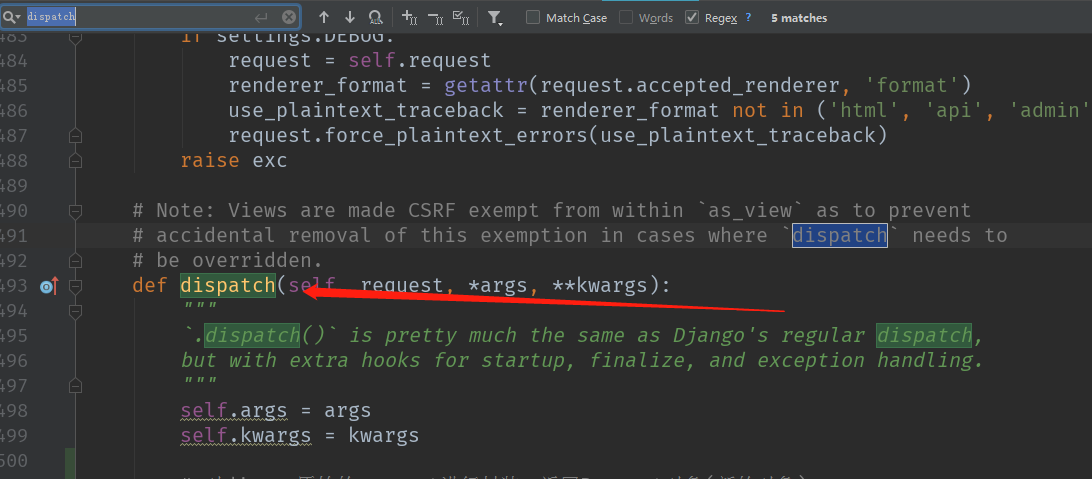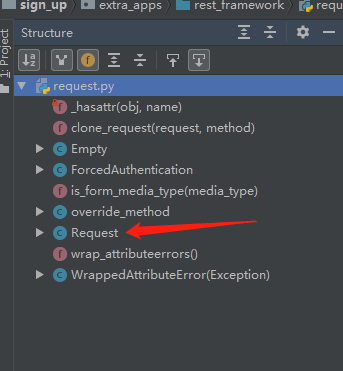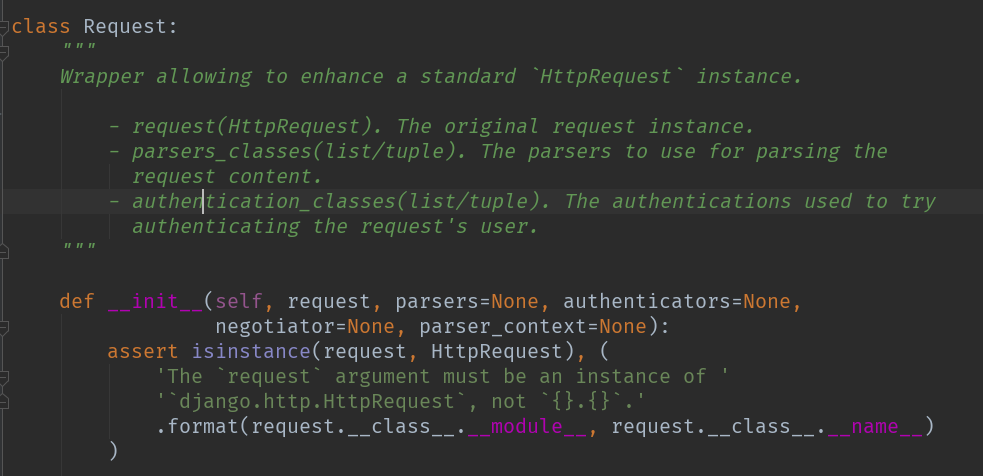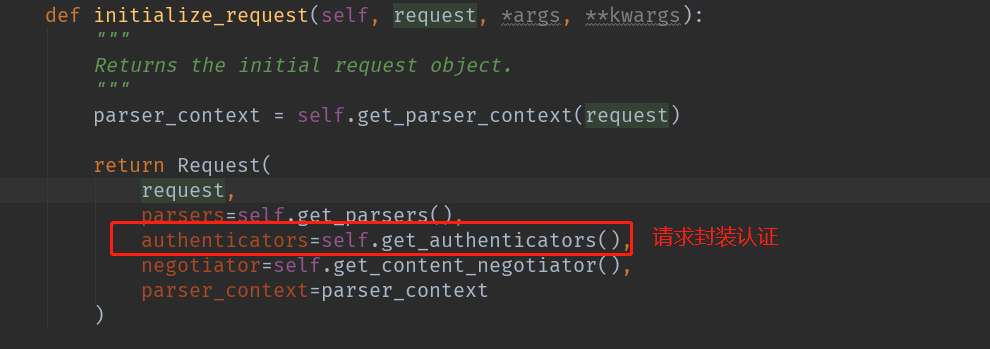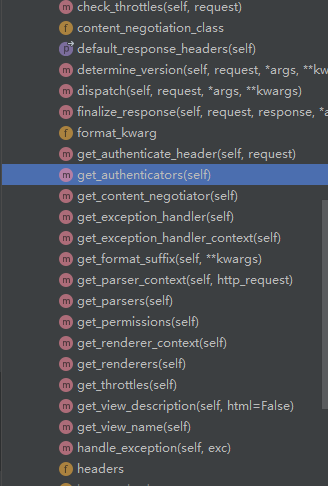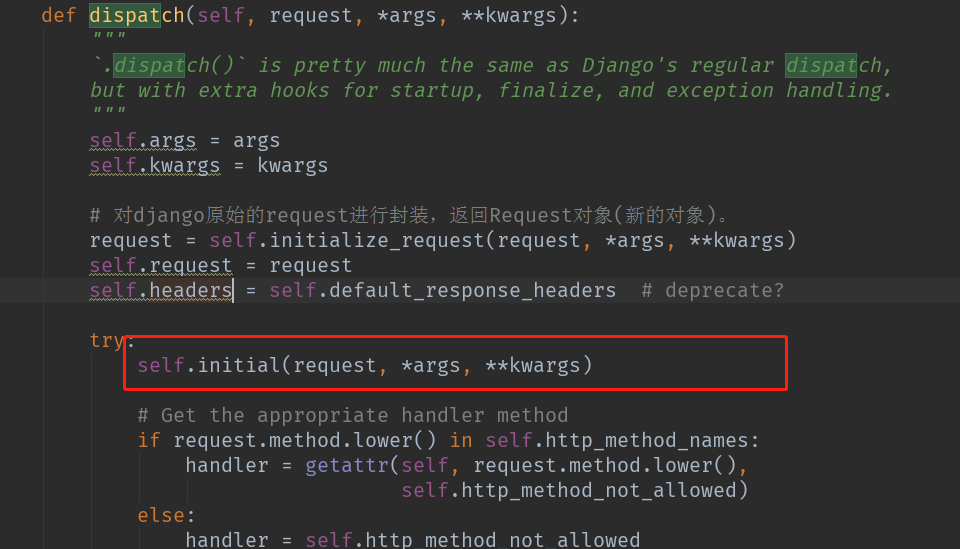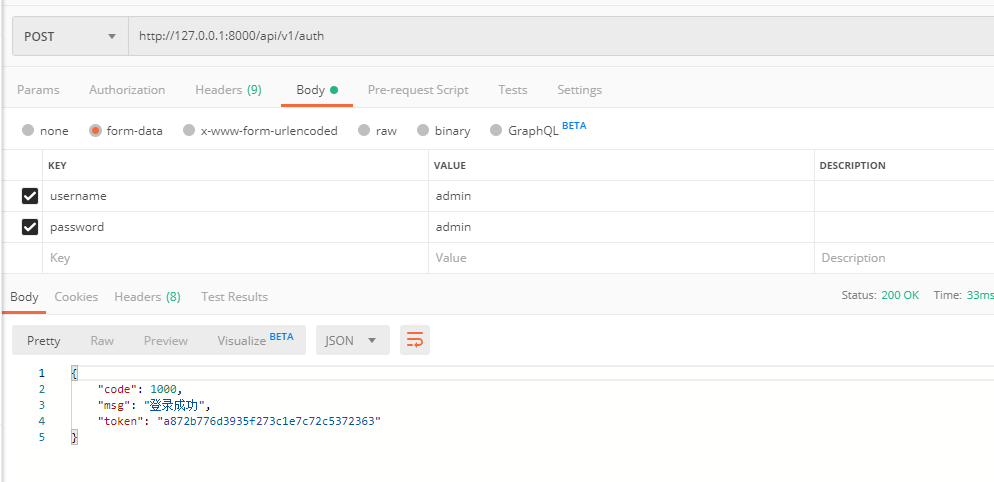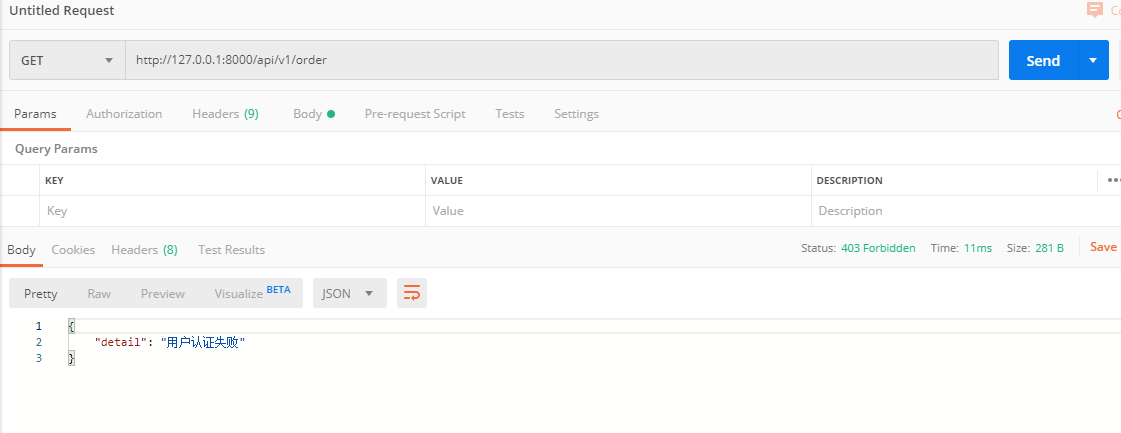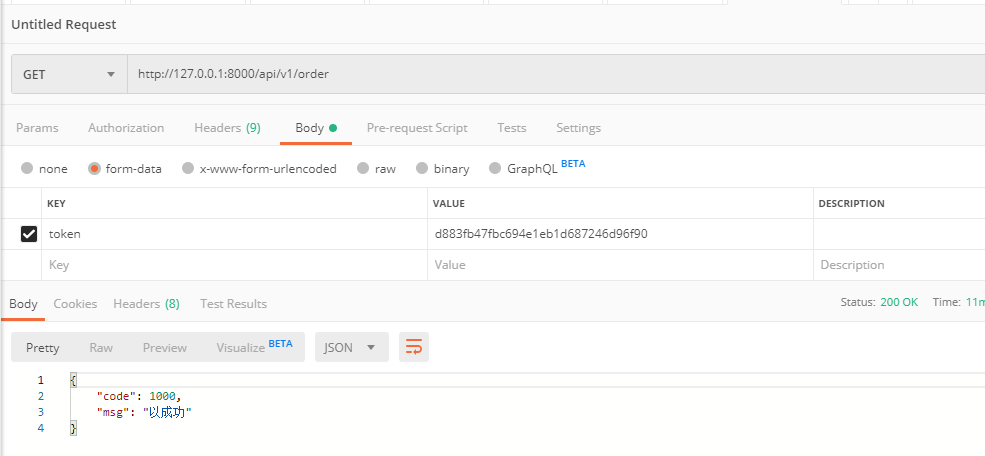一、在django中客户端发来的请求会执行视图类的as_view方法,而as_view方法会执行dispatch方法,然后进行反射执行相应的方法(get、post等)
反射:通过字符串的形式操作对象相关的属性
https://www.chenshaowen.com/blog/reflection-of-python.html
1. getattr(object,‘name‘,‘default’)
如果存在name的属性方法,则返回name的属性方法,否则返回default的属性方法。
2. hasattr(object, ’name‘)
判断对象object是否包含名为name的属性方法,存在则返回True,否则返回False。hasattr是通过调用getattr(ojbect, ’name‘)是否抛出异常来实现)。
3. setattr(object,‘name’,’default‘)
设置对象object的name属性值为default,如果没有name属性,那么创建一个新的属性。
4. delattr(object,’name’)
删除对象object的name属性值。
https://www.chenshaowen.com/blog/reflection-of-python.html
二、drf中的APIView中只要重写as_view()方法
重写dispatch方法,就能加入相对应的功能,我们来看下drf中APIView中as_view()方法# 类方法
@classmethod
def as_view(cls, **initkwargs):
"""
Store the original class on the view function.
This allows us to discover information about the view when we do URL
reverse lookups. Used for breadcrumb generation.
"""
# 检查类中定义的queryset是否是这个models.query.QuerySet类型,必行抛异常
if isinstance(getattr(cls, 'queryset', None), models.query.QuerySet):
def force_evaluation():
raise RuntimeError(
'Do not evaluate the `.queryset` attribute directly, '
'as the result will be cached and reused between requests. '
'Use `.all()` or call `.get_queryset()` instead.'
)
cls.queryset._fetch_all = force_evaluation
# 执行父类的as_view方法
view = super().as_view(**initkwargs)
view.cls = cls
view.initkwargs = initkwargs
# Note: session based authentication is explicitly CSRF validated,
# all other authentication is CSRF exempt.
# 返回view,由于是前后端分离就取消csrf认证
return csrf_exempt(view)小结
这个方法是APIView里面的,我们可以看到他执行了父类的as_view方法,
也就相当于初始化父类,我们接下来看下最基础django中父类View中的as_view方法是怎么样的class View:
# 类方法
@classonlymethod
def as_view(cls, **initkwargs):
"""Main entry point for a request-response process."""
for key in initkwargs:
if key in cls.http_method_names:
raise TypeError("You tried to pass in the %s method name as a "
"keyword argument to %s(). Don't do that."
% (key, cls.__name__))
if not hasattr(cls, key):
raise TypeError("%s() received an invalid keyword %r. as_view "
"only accepts arguments that are already "
"attributes of the class." % (cls.__name__, key))
def view(request, *args, **kwargs):
self = cls(**initkwargs)
if hasattr(self, 'get') and not hasattr(self, 'head'):
self.head = self.get
self.request = request
self.args = args
self.kwargs = kwargs
return self.dispatch(request, *args, **kwargs)
view.view_class = cls
view.view_initkwargs = initkwargs
# take name and docstring from class
update_wrapper(view, cls, updated=())
# and possible attributes set by decorators
# like csrf_exempt from dispatch
update_wrapper(view, cls.dispatch, assigned=())
return view小结
父类绕来绕去还是去执行self.dispatch了,下面我们来总结下上面的执行过程
1、View 的执行顺序:
as_view()方法-----》返回view函数名称(一旦有请求来了就必须要执行as_view方法,然后再执行dispatch方法)
2、APIView 的执行顺序
执行父类as_view方法---》执行dispath方法(APIView重写dispath方法)
==问==:这个看来没有封装什么,只是检查了是否queryset值的类型,然后由于前后端分取消csrf认证
==答==:他执行了
view = super().as_view(**initkwargs)
就一定会执行dispatch()方法
==疑问==:会不会重写了dispatch()方法呢?,搜索一下def dispatch(self, request, *args, **kwargs):
"""
`.dispatch()` is pretty much the same as Django's regular dispatch,
but with extra hooks for startup, finalize, and exception handling.
"""
self.args = args
self.kwargs = kwargs
# 对django原始的request进行封装,返回Request对象(新的对象)。
request = self.initialize_request(request, *args, **kwargs)
self.request = request
self.headers = self.default_response_headers # deprecate?
try:
# 这里的request是新封装的request,然后进一步封装,加入新的一些功能,比如认证,限速,权限
self.initial(request, *args, **kwargs)
# Get the appropriate handler method
if request.method.lower() in self.http_method_names:
handler = getattr(self, request.method.lower(),
self.http_method_not_allowed)
else:
handler = self.http_method_not_allowed
response = handler(request, *args, **kwargs)
except Exception as exc:
response = self.handle_exception(exc)
self.response = self.finalize_response(request, response, *args, **kwargs)
return self.response小结
这里我们可以知道APIView 重写了父类View的dispatch
1. 从这里我们可以知道
2. 对django原始的request进行封装,返回Request对象(新的对象)。
request = self.initialize_request(request, *args, **kwargs)
我们接下来看看他在原有的request基础上封装了什么
def initialize_request(self, request, *args, **kwargs):
"""
Returns the initial request object.
"""
parser_context = self.get_parser_context(request)
# 这里将原来的request封装进来,加入新的功能
return Request(
request,
parsers=self.get_parsers(),
# 加入认证
authenticators=self.get_authenticators(),
negotiator=self.get_content_negotiator(),
parser_context=parser_context
)这里我们可以知道返回了一个新的Request,到低封装了什么呢?
新的Request他封装了
- 请求(HttpRequest)。原始请求实例
- 解析器类(列表/元组)。用于分析
- 请求内容。
- 身份验证类(列表/元组)。用于尝试的身份验证
这里我们由于是分析他的认证就不对他封装的其他进行说明,我们还是回到在APIView中
1. self.get_authenticators()源码分析,采用列表生成式,循环self.authentication_classes,实例化其中的每一个类,返回列表。
2. 不难发现authentication_classes属性正式我们在认证的时候用到认证类列表,这里会自动寻找该属性进行认证。
3. 倘若我们的视图类没有定义认证方法呢?,当然django rest framework 已经给我们加了默认配置,
4. 如果我们没有定义会自动使用settings中的DEFAULT_AUTHENTICATION_CLASSES作为默认(全局)下面是APIView类中的共有属性self.authentication_classes
我们上面分析了APIView在原有的request基础上封装了一些其他功能
self.initialize_request(request, *args, **kwargs)
我们继续分析往下从diapath()这个方法往下走
我们可以看到他是将我们封装后的新的request继续往下传递,然后执行
# 这里的request 是封装后的request,传入def initial(self, request, *args, **kwargs)这个方法
def initial(self, request, *args, **kwargs):
"""
Runs anything that needs to occur prior to calling the method handler.
"""
self.format_kwarg = self.get_format_suffix(**kwargs)
# Perform content negotiation and store the accepted info on the request
neg = self.perform_content_negotiation(request)
request.accepted_renderer, request.accepted_media_type = neg
# Determine the API version, if versioning is in use.
version, scheme = self.determine_version(request, *args, **kwargs)
request.version, request.versioning_scheme = version, scheme
# Ensure that the incoming request is permitted
# 身份认证
self.perform_authentication(request)
# 检查权限
self.check_permissions(request)
# 流量限速
self.check_throttles(request)原来他是调用了这个方法完成认证。我们继续看下这个方法是如何完成认证的def perform_authentication(self, request):
"""
Perform authentication on the incoming request.
Note that if you override this and simply 'pass', then authentication
will instead be performed lazily, the first time either
`request.user` or `request.auth` is accessed.
"""
request.user他返回的是新封装request的user属性。那我们就得看下他源码是如何封装这个属性,以及user这个属性表示什么
@property
def user(self):
"""
Returns the user associated with the current request, as authenticated
by the authentication classes provided to the request.
返回与当前请求关联的经过身份验证的用户,提供给请求的身份验证
"""
# 判断如果_user 不在request中的话,执行 self._authenticate()这个方法
if not hasattr(self, '_user'):
with wrap_attributeerrors():
# 执行认证方法
self._authenticate()
return self._user这里面的user是在新的封装的request这个类中找的
我们可以看到他其实还是执行了self._authenticate()。我们还是要看下他的这个authenticate()方法。
def _authenticate(self):
"""
Attempt to authenticate the request using each authentication instance
in turn.
"""
for authenticator in self.authenticators:
try:
# 执行认证类的authenticate方法
# 这里分三种情况
# 1.如果authenticate方法抛出异常,self._not_authenticated()执行
# 2.有返回值,必须是元组:(request.user,request.auth)
# 认证类的实例执行authenticate()这个方法,这个可以重写自己的代码逻辑
user_auth_tuple = authenticator.authenticate(self)
except exceptions.APIException:
self._not_authenticated()
raise
# 3.返回None,表示当前认证不处理,等下一个认证来处理
if user_auth_tuple is not None:
self._authenticator = authenticator
# 返回值对应示例中的token_obj.user和token_obj
self.user, self.auth = user_auth_tuple
return
self._not_authenticated()小结
1. 这里他将执行每一个认证类的实例的authenticate()方法,也就是说如果要写认证类的话是必须写这个方法的
2. 必须要求返回元祖,然后元祖不为空时就将元祖内的user赋值给self.user,其实也就是侧面赋值给了self._user,
返回到self.perform_authentication(request)这里,其实也就是返回了这个self._user,使得我们认证知道请求是谁,是否登录的作用
class ForcedAuthentication:
"""
This authentication class is used if the test client or request factory
forcibly authenticated the request.
"""
def __init__(self, force_user, force_token):
self.force_user = force_user
self.force_token = force_token
# 一定返回元组
def authenticate(self, request):
return (self.force_user, self.force_token)这个认证工厂要求必须返回元祖
def _not_authenticated(self):
"""
Set authenticator, user & authtoken representing an unauthenticated request.
Defaults are None, AnonymousUser & None.
"""
self._authenticator = None
if api_settings.UNAUTHENTICATED_USER:
self.user = api_settings.UNAUTHENTICATED_USER()
else:
self.user = None
if api_settings.UNAUTHENTICATED_TOKEN:
self.auth = api_settings.UNAUTHENTICATED_TOKEN()
else:
self.auth = None小结
没有身份,相当于匿名用户,默认设置AnonymousUser,如需要单独设置匿名用户返回值,
则编写需要写UNAUTHENTICATED_USER的返回值
所以我们需要认证的时候,需要在每一个认证类中定义authenticate进行验证,并且需要返回元祖
。
我们知道全局配置都在api_setting中
其中引用了django,settings.py中的REST_FRAMEWORK作为key作为配置,所以全局配置示例:
#全局认证配置
REST_FRAMEWORK = {
"DEFAULT_AUTHENTICATION_CLASSES":['API.utils.auth.Authentication',] #其中写认证的类的路径,不要在views中,这里我放在了utils目录下auth.py中
}局部某个视图不需要认证,则在视图类中加入authentication_classes=[]
authentication_classes = [] #authentication_classes为空,代表不需要认证REST_FRAMEWORK = {
"DEFAULT_AUTHENTICATION_CLASSES":['API.utils.auth.Authentication',], #其中写认证的类的路径,不要在views中,这里我放在了utils目录下auth.py中
"UNAUTHENTICATED_USER": lambda:"匿名",#匿名用户配置,只需要函数或类的对应的返回值,对应request.user="匿名"
"UNAUTHENTICATED_token": None,#匿名token,只需要函数或类的对应的返回值,对应request.auth=None
}- BaseAuthentication
BaseAuthentication是django rest framework为我们提供了最基本的认证类,正如源码流程一样,该类中其中定义的两个方法authenticate和authenticate_header(认证失败返回的响应头),使用时候重写该两个方法进行认证,正如示例:
class BaseAuthentication(object):
"""
All authentication classes should extend BaseAuthentication.
"""
def authenticate(self, request):
"""
Authenticate the request and return a two-tuple of (user, token).
"""
raise NotImplementedError(".authenticate() must be overridden.")
def authenticate_header(self, request):
"""
Return a string to be used as the value of the `WWW-Authenticate`
header in a `401 Unauthenticated` response, or `None` if the
authentication scheme should return `403 Permission Denied` responses.
"""
pass其他认证类
rest_framework.authentication
BasicAuthentication #基于浏览器进行认证
SessionAuthentication #基于django的session进行认证
RemoteUserAuthentication #基于django admin中的用户进行认证,这也是官网的示例
TokenAuthentication #基于drf内部的token认证自定义认证类
继承BaseAuthentication,重写authenticate方法和authenticate_header(pass就可以),authenticate()方法需要有三种情况(返回元祖、出现异常、返回none)。
认证配置
#全局认证
REST_FRAMEWORK = {
"DEFAULT_AUTHENTICATION_CLASSES":['API.utils.auth.Authentication',]
}
#局部认证
authentication_classes = [BaseAuthentication,]
#是某个视图不进行认证
authentication_classes =[]- models
from django.db import models
class UserInfo(models.Model):
username = models.CharField(max_length=32,unique=True)
password = models.CharField(max_length=64)
class UserToken(models.Model):
user = models.OneToOneField(to=UserInfo)
token = models.CharField(max_length=64)
- urls.py
from django.conf.urls import url
from django.contrib import admin
from .models import views
urlpatterns = [
url(r'^api/v1/auth', views.AuthView.as_view()),
url(r'^api/v1/order', views.OrderView.as_view()),
]
- views.py
from django.shortcuts import HttpResponse
from django.http import JsonResponse
from rest_framework.views import APIView
from rest_framework.authentication import BaseAuthentication
from . import models
from rest_framework import exceptions
import hashlib
import time
class Authentication(BaseAuthentication):
"""
认证类
"""
def authenticate(self, request):
token = request._request.GET.get("token")
toke_obj = models.UserToken.objects.filter(token=token).first()
if not toke_obj:
raise exceptions.AuthenticationFailed("用户认证失败")
return (toke_obj.user, toke_obj) # 这里返回值一次给request.user,request.auth
def authenticate_header(self, val):
pass
def md5(user):
ctime = str(time.time())
m = hashlib.md5(bytes(user,encoding="utf-8"))
m.update(bytes(ctime,encoding="utf-8"))
return m.hexdigest()
class AuthView(APIView):
"""登陆认证"""
def dispatch(self, request, *args, **kwargs):
return super(AuthView, self).dispatch(request, *args, **kwargs)
def get(self, request, *args, **kwargs):
return HttpResponse('get')
def post(self, request, *args, **kwargs):
ret = {'code': 1000, 'msg': "登录成功"}
try:
user = request._request.POST.get("username")
pwd = request._request.POST.get("password")
obj = models.UserInfo.objects.filter(username=user, password=pwd).first()
if not obj:
ret['code'] = 1001
ret['msg'] = "用户名或密码错误"
else:
token = md5(user)
models.UserToken.objects.update_or_create(user=obj, defaults={"token": token})
ret['token'] = token
except Exception as e:
ret['code'] = 1002
ret['msg'] = "请求异常"
return JsonResponse(ret)
class OrderView(APIView):
'''查看订单'''
authentication_classes = [Authentication,] #添加认证
def get(self,request,*args,**kwargs):
#request.user
#request.auth
ret = {'code':1000,'msg':"你的订单已经完成",'data':"买了一个mac"}
return JsonResponse(ret,safe=True)
默认数据库中userInfo表中已经有了用户名和密码admin,admin
访问这个接口
出现token,如果没有带token去访问一个已经设置了认证的接口的话,会不能访问
带上token去访问
小结
class Authentication(BaseAuthentication):
"""
认证类
"""
def authenticate(self, request):
token = request.data.get("token")
toke_obj = models.UserToken.objects.filter(token=token).first()
if not toke_obj:
raise exceptions.AuthenticationFailed("用户认证失败")
return (toke_obj.user, toke_obj) # 这里返回值一次给request.user,request.auth
这里我们写了一个基本的认证类,然后配置在这个视图类中
class OrderView(APIView):
'''查看订单'''
authentication_classes = [Authentication,] #添加认证
在复杂多变的认证环境中,比如有些视图类不许不是vip的登录等等等。
都可以写在认证类中,这样我们才能在需求多变的情况下实现扩展认证本质是在请求类中封装了认证属性,其实他也就个看门的,他做的就是最终得到Request类user属性。
提供了请求查询来的是谁的这个需求,然后根据业务对这个需求进行自己的改写
